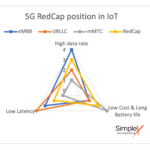
How to prepare for 5G RedCap (Reduced Capacity) for your IoT projects?
January 22, 2024
2024 Cellular Connected IoT Trends in USA
February 5, 2024The Evolution and Importance of Cellular-Enabled GPS Tracking Devices
In the age of digital transformation, the ability to track assets in real-time has become paramount. From personal items like pets to business assets such as fleet vehicles, cellular-enabled GPS tracking devices have emerged as the go-to solution. Leading this innovation is Simplex Wireless, but understanding the landscape requires a deeper dive into the world of cellular IoT connectivity.
The Cellular IoT Landscape in GPS Tracking
The buzz around 5G has been deafening, promising super-fast speeds, enhanced responsiveness, and ultra-low latency. But what does this mean for the 4G GPS tracking devices many have invested in?
GPS tracking devices, whether 4G or 5G, are essentially sensors. They gather data – location, temperature, on/off status, and more. However, these devices need a communication medium to relay this data. This is where Cellular IoT comes into play. It leverages existing mobile networks, covering a staggering 95% of the global population with at least a basic 2G network.
Interestingly, most IoT and GPS devices don’t need the high-speed bandwidth that consumer cellular devices demand. They transmit smaller packets of data, like the daily GPS coordinates of an asset. This is where technologies like LTE-M and NB-IoT, part of the 4G-LTE specification introduced in 2016, become crucial. These Cellular IoT networks are low-power, wide-area networks (LPWANs) that offer long battery life, enhanced coverage, and affordable connectivity options.
LTE-M vs. NB-IoT: The Cellular IoT Titans
Both LTE-M and NB-IoT are pivotal for IoT and Machine to Machine (M2M) applications. But how do they differ?
- Bandwidth: NB-IoT operates on a narrow bandwidth (200kHz), while LTE-M uses a much broader 1.4GHz.
- Data Transfer Rate: NB-IoT can transfer data at around 250kb per second, whereas LTE-M is about four times faster, reaching up to 1Mbps.
- Cellular Tower Handover: LTE-M supports this feature, ensuring continuous connection even when moving between cellular towers. NB-IoT lacks this, dropping the connection if a device moves out of range.
- Power Consumption: Both networks are energy-efficient, but their data transfer rates can influence the power used during data uploads.
For tracking applications, NB-IoT is ideal for stationary assets reporting infrequently, like checking if a fire alarm is powered. Its devices are simpler and often more cost-effective. LTE-M, on the other hand, is perfect for tracking moving assets like vehicles, requiring more frequent data updates.
Simplex Wireless: Connecting Cellular GPS Solutions
With the landscape defined, it’s clear why Simplex Wireless stands out. Their global coverage, advanced cellular technologies, and user-friendly solutions make them a top choice for those venturing into cellular GPS tracking.
Conclusion
The world of cellular-enabled GPS tracking is vast and ever-evolving. With 5G on the horizon and the continuous advancements in 4G technologies, the future is promising. Companies like Simplex Wireless, with their innovative solutions, are ensuring that businesses and individuals can harness the power of cellular IoT for precise, real-time tracking. Whether you’re tracking a fleet of vehicles or ensuring the safety of personal assets, the combination of Cellular IoT and GPS is the way forward.


